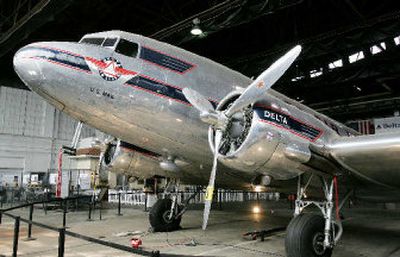Museums with all the props

ATLANTA, Ga. — A converted maintenance room of Delta Air Lines Inc.’s very first airplane hangar holds some of the airline’s treasures — one of the company’s original passenger tickets, old photos from the company’s cropdusting days, and decades of flight attendant uniforms.
Much larger artifacts — actual planes once flown by the company — are displayed inside the hangar, from a propeller plane of the era when carrying mail was more profitable than flying passengers to a modern Boeing 767-200, the $30 million jet that airline employees bought for the company in 1982.
Little known to the public, the Delta Air Transport Heritage Museum preserves the company’s 77-year history in two of the airline’s oldest hangars. Within a converted room in one hangar, an archivist collects galley china, saves old uniforms from retirees and even scouts out rare items on eBay.
“The more you know about the collection, the more you know about Delta history,” said Marie Force, the museum’s archives manager.
Elsewhere, through bankruptcies, mergers and other financial turmoil, other airlines also preserve the legacy of commercial flight, either in their own museums or in office displays. For example, American Airlines has aviation pioneer Charles Lindbergh’s old flight logs and a 1940 DC-3 passenger plane, the Flagship Knoxville, preserved at its museum next to the Dallas-Fort Worth International Airport.
The problem is, these airline collections can be difficult for the public to see. Delta’s museum is located at the company’s corporate headquarters, which is not open to the public for security reasons.
Visitors can only catch the museum by appointment, although officials are trying to make the museum more accessible with plans to offer limited hours to the public, such as tours once or twice a week, said museum director Julia Varnedoe. As of now, less than 18,000 people see the museum each year and most of them have ties to the airline, either as employees, retirees or family members.
Even the country’s largest airline museum — the American Airlines C.R. Smith Museum — has difficulty attracting more than 35,000 visitors a year because it’s also located in an out-of-the-way spot. The 13-year-old museum was built on company property at the south end of the Dallas-Fort Worth airport, which is rarely seen by travelers.
“It’s kind of hidden back here alongside the American Airlines conference center. We like to say it’s one of Dallas-Fort Worth’s best-kept secrets,” curator Jeffrey Johns said.
Because few know about these airline museums and they don’t really generate revenue, their curators constantly work amid uncertainty caused by the industry’s financial woes. For example, the Delta museum must wait out the airline’s current bankruptcy problems to learn whether it will be able to use a nearby office building to display more artifacts.
Officials with American’s C.R. Smith Museum are trying to raise money to make it more independent of the airline industry’s financial ups and downs.
“The airlines are there to transport people and make money and even though this history is important to many, the business aspect is probably always going to be the most important. History can take a second seat, especially when you’re struggling financially,” Johns said.
At United Airlines, its artifacts — such as uniforms, model aircraft and other company memorabilia — were removed earlier in the year from the Chicago headquarters of parent company UAL Corp.
“We took the items at our headquarters and either returned them to the private collectors or took items of historical significance and moved some of those to the historic facility in the Denver training center and other locations in the company,” said United spokesman Brandon Borrman.
The Delta museum’s air-conditioned archival storage room — which is slightly smaller than the dining area of a typical fast-food restaurant — contains the company’s earliest existing passenger ticket, a 1929 trip costing $13.25 for a 120-mile flight from Monroe, La., where the airline once was based, to Jackson, Miss.
There’s also a 1931 business card from C.E. Woolman, Delta’s first CEO, that shows the company’s Depression-era roots — it displays a picture of a biplane cropdusting a field — and a 1940s-era photo ID badge, new at the time because of World War II security concerns.
Capt. Michael Quiello, a 26-year Delta pilot and the airline’s current vice president of corporate safety, security and compliance, visits the museum every few weeks, often looking at the company’s old propeller planes.
“I think about who sat in that airplane in the 1940s and who was flying it and who came before me,” Quiello said, adding that the museum has helped him learn more about the company he works for. “As a family, you try to find out your heritage and you kind of get an understanding … the same thing goes for a company.”